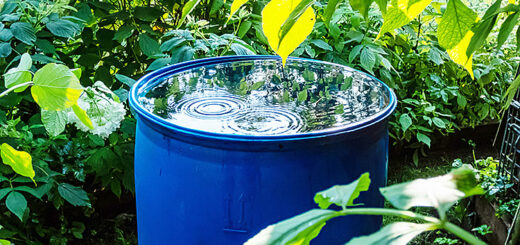Rainwater Catchment Systems Booming in California
By Bobby Markowitz
 Due to the drought and inevitable water use restrictions, the demand for residential and commercial rainwater harvesting systems is growing rapidly in California. The most common use is harvesting rainwater for landscape irrigation. Now there is growing interest in using rainwater for non-potable purposes within buildings such as washing clothes or flushing toilets.
Due to the drought and inevitable water use restrictions, the demand for residential and commercial rainwater harvesting systems is growing rapidly in California. The most common use is harvesting rainwater for landscape irrigation. Now there is growing interest in using rainwater for non-potable purposes within buildings such as washing clothes or flushing toilets.
Whether rainwater is captured for landscape or indoor use, the goal is a Net Zero Demand from a municipal system. A rainwater system for landscape irrigation must balance the supply (storage volume) with the demand (irrigation requirements) in order to create a landscape that requires little or no supplemental water from a water district. The potential water supply must be determined for the site before the landscape is planned to match.
Rainwater is usually captured from the roof of a home, building, or other structure. Rainwater collected from roofs is generally of higher quality than that captured from hard surfaces at ground level (e.g. patios or driveways). Rainwater from downspouts goes through simple filters to storage tanks. From there, the water is pumped and filtered again for the irrigation system. The sizes of the pipes, filters, pumps, and storage system are based on the runoff of a heavy storm for the area. Also, there must be a plan for overflow during an exceptionally heavy storm event.
To achieve a successful Net Zero Demand landscape irrigation system, plant species selection is the most important feature. The goal is to supply most (or all) of the plants’ irrigation needs with the harvested and seasonal rainwater. Fortunately, there is a rich selection of California native and drought-tolerant plants to choose from and several native lawn species requiring little or no water during the summer. Placement of the various plants in the landscape should use hydrozones, which is grouping plants according to water needs.
Above or Below Ground Tanks
An above ground rainwater storage solution is the least expensive to install but also occupies the most space. If they can be screened from view and there is enough room, professionals prefer to use above ground tanks. For small landscapes, attractively designed rainwater tanks can be used. A multiple small tank a system is also an option, but the expense of additional piping, pumps and filtration should be considered.
Underground tank systems have far less spatial and visual impact, but can cost twice as much to install because of the engineering and excavation involved. The tanks are often installed under a driveway, storage building, patio, deck or planting area. Soil type, slope, ground water level, are just some of the details that need to be considered for underground storage.
Rainwater harvesting systems are worth the investment if Net Zero Demand can be achieved.
About the Author
Bobby Markowitz is a California licensed senior landscape architect for Ecological Concerns Incorporated (ECI), a design, grow, build ecological landscape firm located in Santa Cruz serving the Monterey and San Francisco Bay Areas. For more information please visit: www.ecologicalconcerns.com




